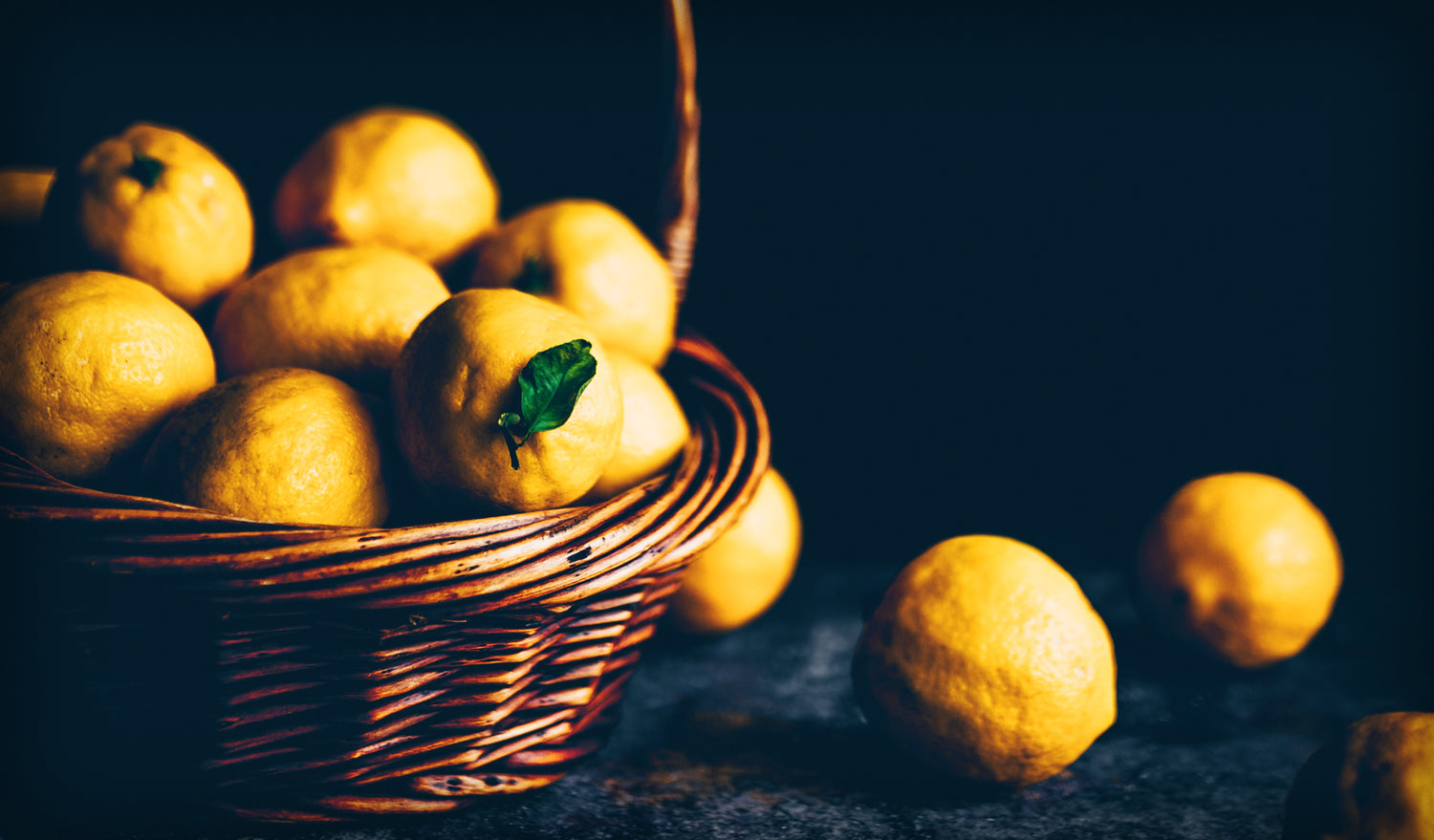LEMON
The lemon (Citrus limon) is part of the Rutaceae Family. The small, oval fruit is approximately 2 to 3 inches in diameter. With its bright yellow, pitted outer peel, like that of other citrus food, the inner flesh of the lemon is encased in approximately 8 to 10 segments. The lemon has a characteristic, sour odor with an acidic, tart, astringent taste that is unexpectedly refreshing.
The fruit juice contains mainly sugars and fruit acids, which are made of mainly citric acid. Lemon peel consists of two layers; the outer most layer (“zest”), which contains essential oils (6%) that are composed mostly of limonene (90%) and citral (5%), plus a small amount of citronellal, alpha-terpineol, linalyl, and geranyl acetate. The inner layer contains no essential oil but instead houses a variety of bitter flavon glycosides and coumarin derivatives.
Despite the misconception that lemons are only sour, there is also a sweet variety. The most notable sweet lemon is the Meyer lemon, which is becoming increasingly more popular in markets and restaurants. It has a much rounder form and a smooth unpermitted skin, and takes on a deep yellow to orange color when mature. Meyer lemons have an amazing tangy aroma and are less acidic. The two main sour lemons are the Eureka and the Lisbon. The Eureka has fewer seeds and a more textured skin, while the Lisbon is smoother and seedless.
Lemon trees are much less hearty in their tolerance for cold than orange trees, hence they have been difficult to cultivate. However, the lemon tree flowers continuously and has fruit in all stages of the development most of the year. A tree may bear as many as 3000 lemons annually.
HISTORY
Citrus fruits are native to southern China and south east Asia, where they have been cultivated for approximately 4000 years. In fact, ancient Asian literature includes stories about these fruits. The citron was carried to the Middle East sometime between 400 and 600 B.C.E. Arab traders in Asia carried lemons, citrons, limes, oranges, and shaddocks to eastern Africa and the Middle East between C.E. 100 and 700.
During the Arab occupation of Spain, citrus fruits arrived in southern Europe. From there, they were taken to the New World by Christopher Columbus in Portuguese and Spanish explorers. Lemons became quite well-known in Florida and Brazil by the 16th century. Superior varieties from south east Asia arrived in Europe with Portuguese traders in the 16th century. Mandarin oranges from southern China did not arrive in Europe in the New World until the 19th century.
The desire for citrus fruits increased greatly after the 1890s when physicians found that people suffering from scurvy (a disease of vitamin C deficiency) could be cured by drinking citrus juice. Lemons were in such demand that people were willing to pay up to one dollar per lemon an astronomical price for that time! Later, scientist discovered that the juice is beneficial because it is the most potent and concentrated source of vitamin C. Lemons also contain vitamins a, B1, and P, as well as potassium, magnesium, and folic acid.
The United States (California and Florida lead in US production), Italy, Spain, Greece, Israel, and Turkey are the major producers of lemons.
NUTRITIONAL HIGHLIGHTS
Lemons are an excellent source of vitamin C. In addition, they are a good source of vitamin B6, potassium, folic acid, flavonoids, and the important phytochemical limonene.
HEALTH BENEFITS
The phytochemical limonene, which is extracted from lemons, is currently being used in clinical trials to dissolve gallstones and is showing extremely promising anti-cancer activities. The highest content of limonene is found in the white spongy inner parts of the lemon.
SELECTION & STORAGE
When choosing a lemon, one should hold the fruit and determine if it is heavy. The heavier the fruit in the center of the skin, the more juice it has. A ripe lemon should be firm, with a fine textured peel with a deep yellow color. Acidity varies with the color of the lemon. A deep yellow lemon is less acidic then a lighter or a greenish yellow one. Surface marks usually do not affect the fruit inside, but you should try to avoid buying bruised or dried out fruit, as well as shriveled or hard skin lemons.
Store lemons at room temperature, away from sunlight, and enjoy their cheerful color. They keep without refrigeration for about two weeks. If kept in the refrigerator crisper, it is best to use a plastic bag, where they can remain up to six weeks.
Lemons can also be juiced and stored for later use. First, squeeze the lemons and pour the juice into ice cube trays for freezing. You can then transfer the frozen cubes to a plastic freezer container, where they will keep for up to three months. Lemon zest, which is usually used as a spice, can be dried and stored in a cool place for up to 2 to 3 months.
PREP TIPS
Lemons in many forms are called for in countless recipes. To produce more lemon juice for a recipe, it is always better for the lemon to be warm or at least room temperature. If time is a factor, lemon can be placed in a bowl of warm water or in the microwave for 5 to 10 seconds, or juice in a juicer or extractor. Rolling the lemon under the palm of your hand on a flat surface will ensure the extraction of more juice. It is also important to note that before cutting a lemon, it is a good idea to wash the skin of the lemon so that any dirt or bacteria on the skin is not transferred to the fruits interior. Use caution if you have a citrus allergy.
It is always recommended, if you are using the skin or zest of any citrus, to purchase organic fruit. Most conventionally harvested fruits have pesticide residue concentrated under skin. To obtain the zest of a lemon first wash and dry the lemon, then use a paring knife or vegetable peeler to remove the colored part of the lemon. The white pith that is under the peel has a very bitter taste and should not be used. The zest can be chopped, diced, candied, or used in whatever fashion called for by that recipe.
SAFETY
Some people are allergic to citrus peels. When such an allergy is suspected, caution must be employed when eating citrus fruit. But whether you are allergic or not, citrus peels should not be eaten in any significant quantity. Citrus peels contain some beneficial oils, but these oils can interfere with some body functions. For example citrus peels contain a compound known as citral that antagonizes some of the effects of vitamin A.
Lemons contain low levels of oxalates; lemon peel, however, contains high levels of oxalates. Individuals with a history of calcium oxalate containing kidney stones should limit their consumption of this food.
Since lemons are among the foods on which pesticide residues have been found most frequently, we recommend selecting organically grown lemons.
RESOURCES
- The Encyclopedia of Healing Food by Michael Murray, ND



